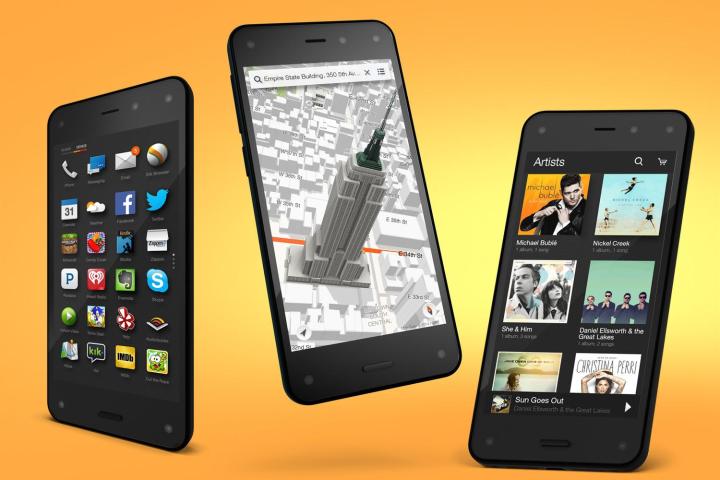
After having been a member of the rumor mill for several years, Amazon’s smartphone has finally seen the light of day. Called the Fire Phone, its claim to fame is those four front-facing sensors found on the corners of the handset. The sensors enable what Amazon calls Dynamic Perspective, the company’s term for gesture-based input methods.
Even so, let’s take a look at how the Fire Phone stacks up against Apple’s gold standard, the iPhone 5S, in this quick side-by-side comparison.
|
iPhone 5S  |
Amazon Fire Phone  |
|
| Size | 123.8 x 58.6 x 7.6 (mm) | 139.2 x 66.5 x 8.9 (mm) |
| Weight | 112g | 160g |
| Screen | 4.0-inch LCD | 4.7-inch 720p IPS |
| Resolution | 1136 x 640 pixels | 1280 x 720 pixels |
| OS | iOS 7.1 | Fire OS 3.5 |
| Storage | 16GB, 32GB, or 64GB | 32GB or 64GB |
| SD Card Slot | No | No |
| Processor | 64-bit A7 chip | Quad-core 2.2GHz Snapdragon 800 |
| RAM | 1GB | 2GB |
| Connectivity | Wi-Fi, LTE, HSPA+ | Wi-Fi, LTE, HSPA+, NFC |
| Camera | Front 1.2MP, Rear 8MP | Front 2.1M, Rear 13MP |
| Motion Processor | M7 chip | None |
| Fingerprint Sensor | Yes | No |
| Bluetooth | Yes, version 4.0 | Yes, version 3.0 |
| Battery | 1570mAh | 2400mAh, removable |
| Charger | Lightning connector | Micro USB, wireless |
| Marketplace | Apple App Store | Amazon Appstore |
| Ave. Price | $200+ | $200+ |
| Availability | AT&T, Sprint, Verizon, T-Mob | AT&T |
| DT Review | 4.5 out of 5 | TBA |
Processing power
This is one area that both Apple and Amazon downplay. While Apple incorporated a 64-bit processor in the form of the A7, as well as a motion processor, it doesn’t make that much of a difference in day-to-day use. The Fire Phone uses a processor found in last year’s flagships, though in day-to-day use, it should still perform admirably.
While both operating systems seem well optimized for their respective chipsets, we’re concerned about the Dynamic Perspective feature found in the Fire Phone. It’s a wait-and-see affair as to how much of an impact it will have on a day-to-day basis. It could slow down the phone, though the lower-resolution 720p screen should help it.
Design
Normally, we wouldn’t talk about design when it comes to smartphones, seeing as the large majority are basically rectangles with screens these days, but the Fire Phone introduces four front-facing sensors, one placed on each corner of the handset. These sensors allow for the aforementioned Dynamic Perspective, which lets you interact with the interface by tilting, and swerving the handset as you move.
For example, if you want to look at the Empire State Building from several different angles, you can tilt the Fire Phone to do so. In addition, you can browse the Web by tilting the handset to your liking in order to scroll. Another example involves tilting the handset to go through products you might be interested in buying.
Other than those rather inconspicuous sensors, however, the Fire Phone is more of the same. The same can be said for the iPhone 5S, though it introduced Touch ID when it was released back in September of last year.
Camera
Another noteworthy aspect of both handsets is the camera. The eight installment of the iPhone Photography Awards showed us that the iPhone 5S’ rear-facing shooter should not be taken lightly. At the same time, Amazon announced several camera-centric features of the Fire Phone.
Amazon made a small jab at Apple by comparing a nighttime shot taken with the Fire Phone with a shot taken with the iPhone 5S. Based on the comparison, the Fire Phone’s picture came out clearer than the one taken by the iPhone 5S. Amazon is also giving Fire Phone owners free unlimited photo cloud storage through the company’s Cloud Drive service.
As for hard numbers, the Fire Phone’s camera is a 13-megapixel variant with optical image stabilization versus the 8-megapixel shooter on the iPhone 5S. Megapixels aren’t everything, so we’ll have to test out the Fire Phone’s camera to see if it properly stacks up.
Conclusion
It’s awkward when a specification showdown pits two phones against each other that downplay specs. While the iPhone 5S and Fire Phone aren’t handsets to be ignored in the specification department, both Apple and Amazon emphasize features more than numbers. Both companies tote their respective ecosystems as major differentiators, though Amazon threw one more into the ring: Dynamic Perspective. Apple does have its motion processor and fingerprint Touch ID as differentiators, as well.
It’s a wait-and-see approach in terms of whether developers embrace the feature and incorporate it into their apps, though it will certainly depend on the adoption rate. While Amazon has been around the block, this is the company’s first foray into the smartphone market. It doesn’t help that the Fire Phone will be exclusive to AT&T, whereas the iPhone 5S can be found in all four major wireless carriers, as well as smaller ones. Whether Amazon’s sprawling ecosystem and Dynamic Perspective feature is enough to win over consumers pondering about purchasing an iPhone 5S is unknown, but the online retailer has a long road ahead of it.


